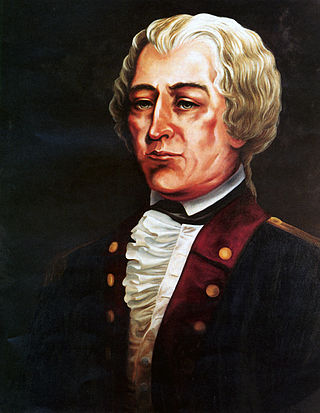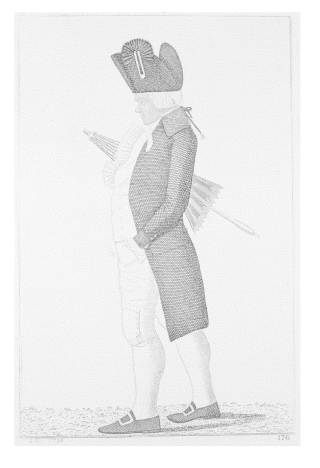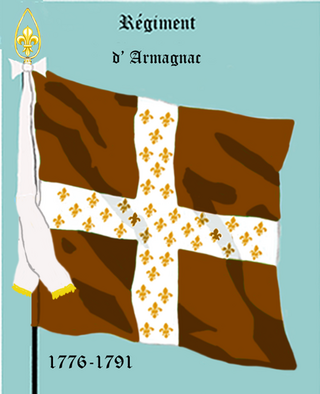
Admiral George Brydges Rodney, 1st Baron Rodney, KB, was a British naval officer. He is best known for his commands in the American War of Independence, particularly his victory over the French at the Battle of the Saintes in 1782. It is often claimed that he was the commander to have pioneered the tactic of breaking the line.

General Sir Banastre Tarleton, 1st Baronet was a British military officer and politician. He is best known as the lieutenant colonel leading the British Legion at the end of the American Revolutionary War. He later served in Portugal and held commands in Ireland and England.

Admiral Sir Richard Hussey Bickerton, 2nd Baronet, KCB, was a British naval officer. He was born in Southampton, the son of Vice-admiral Sir Richard Bickerton and first served aboard HMS Medway in June 1774, in the Mediterranean. His first command came in March 1779 when he was given HM Sloop Swallow as a reward for his part in an engagement with a much larger opponent. Bickerton later joined Rodney's squadron in the West Indies where he took part in the capture of Sint Eustatius in 1781. Making post captain on 8 February 1781, he took temporary command of HMS Invincible and fought in her at the Battle of Fort Royal on 29 April 1781.

Lieutenant-General Robert Monckton was an officer of the British Army and colonial administrator in British North America. He had a distinguished military and political career, being second in command to General James Wolfe at the battle of Quebec and later being named the Governor of the Province of New York. Monckton is also remembered for his role in a number of other important events in the French and Indian War, most notably the capture of Fort Beauséjour in Acadia, and the island of Martinique in the West Indies, as well as for his role in the deportation of the Acadians from British controlled Nova Scotia and also from French-controlled Acadia. The city of Moncton, New Brunswick, and Fort Monckton in Port Elgin, New Brunswick, are named for him. A second more important Fort Monckton in Gosport, England, is also named for him. It remains an active military establishment, and currently houses the British Secret Intelligence Service (MI6) training section. Monckton sat in the British House of Commons between 1774 and 1782. Although never legally married, he had three sons and a daughter.
Lieutenant-General James Robertson was a British Army officer and colonial official who served as the 40th Governor of New York from 1779 to 1783. He was a stage actor in his early adulthood.

John Doughty was an American military officer who briefly served as the senior officer of the United States Army in 1784. Holding the rank of major at the time, he bears the distinction of being the lowest ranked individual ever to serve as the senior most United States Army officer.
St Andrew St John, 14th Baron St John of Bletso PC FRS was an English politician who sat in the British House of Commons from 1780 until 1806 when he inherited a peerage.
The 71st Regiment of Foot was a British Army regiment of infantry raised in 1775, during the American Revolutionary War and unofficially known as Fraser's Highlanders. It was disbanded in 1786.
General Charles Rainsford was a British Army officer.

Eyre Massey, 1st Baron Clarina, was an Anglo-Irish British army officer of the 18th century, known primarily for his successful action at La Belle-Famille during the French and Indian War. In 1800, he was made Baron Clarina in the Peerage of Ireland.
Lieutenant-General James Murray, was a Scottish soldier and politician who sat in the House of Commons from 1773 to 1794.

The Capture of Sint Eustatius took place in February 1781 during the Fourth Anglo-Dutch War when British army and naval forces under Lieutenant-General Sir John Vaughan and Admiral George Rodney seized the Dutch-owned Caribbean island of Sint Eustatius. The capture was controversial in Britain, as it was alleged that Vaughan and Rodney had used the opportunity to enrich themselves and had neglected more important military duties. The island was subsequently taken by Dutch-allied French forces in late 1781, ending the British occupation.
Sir Francis Samuel Drake, 1st Baronet was an officer of the Royal Navy. He served during the Seven Years' War and the American War of Independence, rising to the rank of Rear-admiral of the Red.
Edward Mathew began his military career in the British Army as a commissioned officer. By the time of the American Revolutionary War he had risen to the rank of colonel. Promoted to brigadier general, he was assigned to command the elite Brigade of Guards in the American campaign. In 1776 he led the Guards at Long Island, Kip's Bay, and Fort Washington where he spearheaded one of the assault forces. In the Philadelphia Campaign, he commanded his brigade at Brandywine, Germantown, White Marsh, and Monmouth. As a major general, he took part in the highly successful Chesapeake raid on Virginia ports in 1779. He led one of the columns in action at Battle of Springfield in 1780. He commanded in the West Indies in 1782 and became a full general in 1797. His beloved daughter Anna predeceased him in 1795. Mathew is likely to have been the model for a character in one of Jane Austen's novels.

General Alexander Mackay was a Scottish soldier in the British Army, and a politician. The son of George Mackay, 3rd Lord Reay, he was the younger brother of George Mackay of Skibo (c.1715–1782).
The 88th Regiment of Foot was an infantry regiment in the British Army from 1779 to 1783, formed during the American Revolutionary War. It was raised in Worcestershire under Colonel Thomas Keating and saw service in Jamaica. It was disbanded in England in 1783 at the end of the war.
The 89th Regiment of Foot was an infantry regiment in the British Army from 1779 to 1783.

The Régiment d'Armagnac(Regiment of Armagnac) was a line infantry regiment of the French Royal Army formed in 1776, which served during the American Revolution, and later the War of the First Coalition, until it was disbanded in 1794. Just two years after formation, the regiment would serve during the Anglo-French War seeing action in both North America and the Caribbean. Following their return, a brief period of peace followed until the revolution and subsequent war, which saw the regiment's lineage discontinued.
Admiral John Brisbane (1735–1807) was a Royal Navy officer.









